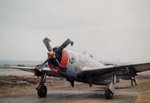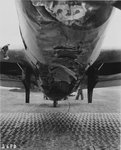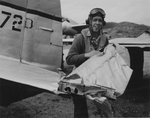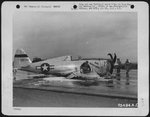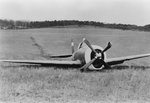seesul
Senior Master Sergeant
Good morning to all,
yesterday I found a picture of damaged P-47D "Dixie Gal" from 57FG, 64 FS, 15 USAAF. The text at the FB page says " Captain Paul Hall's P-47D Thunderbolt fighter 'Dixie Gal' of 57th Fighter Group, US 64th Fighter Squadron at rest at Grosseto, Italy. Captain Paul M. Hall struck the ground during a strafing attack while on a mission near Milan, Italy. He successfully flew the vibrating aircraft 150 miles back to his airfield at Grosseto, Italy."
View: https://www.facebook.com/groups/812798735458957/permalink/1937509376321215/
Although Jug was a very tough airplane I don´t belive that it could fly with such a propeller damage. Not only because of the vibrations but would the propeller be able to produce enough thrust in such a condition to bring this heavy bird to its home A/B?
Looking at the pic of the damaged belly I´d say that the pic shows P-47D that belly landed and then the ground crew got the gear down. Also the prop seems to be damaged while turning on a very low RPM. Just my opinion.
What do you think?
Edit: I´m sorry if this case was already discussed in another thread but I haven´t found anything here so far.
yesterday I found a picture of damaged P-47D "Dixie Gal" from 57FG, 64 FS, 15 USAAF. The text at the FB page says " Captain Paul Hall's P-47D Thunderbolt fighter 'Dixie Gal' of 57th Fighter Group, US 64th Fighter Squadron at rest at Grosseto, Italy. Captain Paul M. Hall struck the ground during a strafing attack while on a mission near Milan, Italy. He successfully flew the vibrating aircraft 150 miles back to his airfield at Grosseto, Italy."
View: https://www.facebook.com/groups/812798735458957/permalink/1937509376321215/
Although Jug was a very tough airplane I don´t belive that it could fly with such a propeller damage. Not only because of the vibrations but would the propeller be able to produce enough thrust in such a condition to bring this heavy bird to its home A/B?
Looking at the pic of the damaged belly I´d say that the pic shows P-47D that belly landed and then the ground crew got the gear down. Also the prop seems to be damaged while turning on a very low RPM. Just my opinion.
What do you think?
Edit: I´m sorry if this case was already discussed in another thread but I haven´t found anything here so far.

